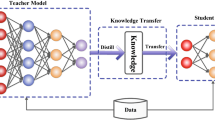Abstract
Domain generalization person re-identification (DG Re-ID) aims to deploy a Re-ID model trained on multiple source domains to unseen domains without adaptation, which is a practical and challenging problem. Due to the significant drop in performance of DG Re-ID methods on unseen target domains, Mixture of Experts (MoE) is used to set up an expert branch for each domain to learn its unique features and thus improve the identification performance on unseen target domains. However, most of the MoE-based DG Re-ID methods only aggregate multiple branch features to simulate the unseen target domain and ignore the role of style in classification recognition among different domains. To address these problems, we propose Style-Adaptive Learning DG Re-ID (SALDG) method, which includes Global Branch, Expert Branches, Class-level Style-adaptive Learning (CSL) module, and Domain-level Style-adaptive Learning (DSL) module. The Global Branch and the Expert Branches extract the global feature and different domain style features respectively. The CSL module can learn the style information of each domain, and the DSL module adaptively mixes the style information of each domain learned by the CSL module to form more complex style information and enhance style diversity in the global feature space. Through extensive experiments, compared with the state-of-the-art methods, the mAP and R-1 accuracy of SALDG on Market1501, DukeMTMC, CUHK03, MSMT17 datasets are improved by approximately 4.1% and 5% respectively.







Similar content being viewed by others
Data availability
The data that support this research are available from the second author Xinsheng Dou, upon reasonable request.
References
Luo H, Jiang W, Gu Y, Liu F, Liao X, Lai S, Gu J (2020) A strong baseline and batch normalization neck for deep person re-identification. IEEE Trans Multimed 22:2597–2609
Lin X, Ren P, Yeh C-H, Yao L, Song A, Chang X (2021) Unsupervised person re-identification: a systematic survey of challenges and solutions. arXiv preprint arXiv:2109.06057
Zhang Y-F, Zhang Z, Li D, Jia Z, Wang L, Tan T (2023) Learning domain invariant representations for generalizable person re-identification. IEEE Trans Image Process 32:509–523
Masoudnia S, Ebrahimpour R (2014) Mixture of experts: a literature survey. Artif Intell Rev 42:275
Choi S, Kim T, Jeong M, Park H, Kim C (2021) Meta batch-instance normalization for generalizable person re-identification. In: Procedings of the IEEE/CVF conference on computer vision and pattern recognition, pp 3425–3435
Xu B, Liang J, He L, Sun Z (2022) Mimic embedding via adaptive aggregation: learning generalizable person re-identification. In: Procedings of the European conference on computer vision, pp 372–388
Liu J, Huang Z, Li L, Zheng K, Zha Z-J (2021) Debiased batch normalization via Gaussian process for generalizable person re-identification. In: Procedings of the AAAI conference on artificial intelligence, pp 1729–1737
Dai Y, Li X, Liu J, Tong Z, Duan L-Y (2021) Generalizable person re- identification with relevance-aware mixture of experts. In: Procedings of the IEEE/CVF conference on computer vision and pattern recognition, pp 16145–16154
Huang X, Belongie S (2017) Arbitrary style transfer in real-time with adaptive instance normalization. In: Procedings of the IEEE international conference on computer vision, pp 1501–1510
Chen H, Zhao C, Tu K, Chen J, Li Y, Li B (2022) Style variable and irrelevant learning for generalizable person re-identification. arXiv preprint arXiv:2209.05235
Qi L, Shen J, Liu J, Shi Y, Geng X (2022) Label distribution learning for generalizable multi-source person re-identification. IEEE Trans Inf Forensics Secur 17:3139–3150
Jiao B, Liu L, Gao L, Lin G, Yang L, Zhang S, Wang P, Zhang Y (2022) Dynamically transformed instance normalization network for generalizable person re-identification. In: Procedings of the European conference on computer vision, pp 285–301
Zhou K, Yang Y, Qiao Y, Xiang T (2021) Domain generalization with mixstyle. In: Procedings of the international conference on learning representations, pp 528–540
Chen K, Gong T, Zhang L (2022) Weighted supervised contrastive learning and domain mixture for generalized person re-identification. In: Procedings of the IEEE international conference on image processing, pp 2606–2610
Zhao Y, Zhong Z, Yang F, Luo Z, Lin Y, Li S, Sebe N (2021) Learning to generalize unseen domains via memory-based multi-source meta-learning for person re-identification. In: Procedings of the IEEE/CVF conference on computer vision and pattern recognition, pp 6277–6286
Kim Y-E, Nam W-J, Min K, Lee S-W (2023) Style selective normalization with meta learning for test-time adaptive face anti-spoofing. Expert Syst Appl 214:119106
Guo Y, He H, Zhu Y, Yu Y (2022) Domain generalization person re-identification on attention-aware multi-operation strategery. arXiv preprint arXiv:2210.10409
Qi L, Wang L, Huo J, Shi Y, Gao Y (2020) Progressive cross-camera soft- label learning for semi-supervised person re-identification. IEEE Trans Circuits Syst Video Technol 30:2815–2829
Chen Y-C, Zheng W-S, Lai J (2015) Mirror representation for modeling view-specific transform in person re-identification. In: Procedings of the international joint conference on artificial intelligence, pp 3402–3408
Liao S, Hu Y, Zhu X, Li SZ (2015) Person re-identification by local maximal occurrence representation and metric learning. In: Procedings of the IEEE conference on computer vision and pattern recognition, pp 2197–2206
Qian X, Fu Y, Xiang T, Wang W, Qiu J, Wu Y, Jiang Y-G, Xue X (2018) Pose-normalized image generation for person re-identification. In: Procedings of the European conference on computer vision, pp 650–667
Zheng L, Shen L, Tian L, Wang S, Wang J, Tian Q (2015) Scalable person re-identification: a benchmark. In: Proceedings of the IEEE international conference on computer vision, pp 1116–1124
Wei L, Zhang S, Gao W, Tian Q (2018) Person transfer gan to bridge domain gap for person re-identification. In: Proceedings of the IEEE conference on computer vision and pattern recognition, pp 79–88
Liao S, Shao L (2020) Interpretable and generalizable person re-identification with query-adaptive convolution and temporal lifting. In: Proceedings of the European conference on computer vision, pp 456–474
Ristani E, Tomasi C (2018) Features for multi-target multi-camera tracking and re-identification. In: Proceedings of the IEEE conference on computer vision and pattern recognition, pp 6036–6046
Loy CC, Xiang T, Gong S (2009) Multi-camera activity correlation analysis. In: Proceedings of the IEEE conference on computer vision and pattern recognition, pp 1988–1995
Qi L, Wang L, Shi Y, Geng X (2022) A novel mix-normalization method for generalizable multi-source person re-identification. IEEE Trans Multimed 25:4856–4867
Shankar S, Piratla V, Chakrabarti S, Chaudhuri S, Jyothi P, Sarawagi S (2018) Generalizing across domains via cross-gradient training. arXiv preprint arXiv:1804.10745
Zhao J, Zhao Y, Chen X, Li J (2022) Revisiting stochastic learning for generalizable person re-identification. In: Proceedings of the ACM international conference on multimedia, pp 1758–1768
Dou Z, Wang Z, Li Y, Wang S (2023) Identity-seeking self-supervised representation learning for generalizable person re-identification. In: Proceedings of the IEEE/CVF international conference on computer vision, pp 15847–15858
Sun Y, Zheng L, Yang Y, Tian Q, Wang S (2018) Beyond part models: Person retrieval with refined part pooling (and a strong convolutional baseline). In: Proceedings of the European conference on computer vision, pp 501–518
Chen P, Dai P, Liu J, Zheng F, Xu M, Tian Q, Ji R (2021) Dual distribution alignment network for generalizable person re-identification. In: Proceedings of the AAAI conference on artificial intelligence, pp 1054–1062
Nichol A, Achiam J, Schulman J (2018) On first-order meta-learning algorithms. arXiv preprint arXiv:1803.02999
Li D, Yang Y, Song Y-Z, Hospedales T (2018) Learning to generalize: meta-learning for domain generalization. In: Proceedings of the AAAI conference on artificial intelligence, pp 600–612
Bai Y, Jiao J, Ce W, Liu J, Lou Y, Feng X, Duan L-Y (2021) Person30k: a dual-meta generalization network for person re-identification. In: Proceedings of the IEEE/CVF conference on computer vision and pattern recognition, pp 2123–2132
Jia J, Ruan Q, Hospedales TM (2019) Frustratingly easy person re-identification: generalizing person re-id in practice. arXiv preprint arXiv:1905.03422
Zhuang Z, Wei L, Xie L, Zhang T, Zhang H, Wu H, Ai H, Tian Q (2020) Rethinking the distribution gap of person re-identification with camera-based batch normalization. In: Proceedings of the European conference on computer vision, pp 140–157
Jin X, Lan C, Zeng W, Chen Z, Zhang L (2020) Style normalization and restitution for generalizable person re-identification. In: Proceedings of the IEEE/CVF conference on computer vision and pattern recognition, pp 3143–3152
Qiao S, Liu C, Shen W, Yuille A (2018) Few-shot image recognition by predicting parameters from activations. In: Proceedings of the IEEE/CVF conference on computer vision and pattern recognition, pp 7229–7238
Zhang X, Luo H, Fan X, Xiang W, Sun Y, Xiao Q, Jiang W, Zhang C, Sun J (2017) Alignedreid: surpassing human-level performance in person re-identification. Cornell University, Ithaca
Fan H, Zheng L, Yan C, Yang Y (2018) Unsupervised person re-identification: clustering and fine-tuning. ACM Trans Multimed Comput Commun Appl 14:1–18
Huang Y, Peng P, Jin Y, Li Y, Xing J (2020) Domain adaptive attention learning for unsupervised person re-identification. AAAI Conf Artif Intell 34:11069–11076
Wang J, Zhu X, Gong S, Li W (2018) Transferable joint attribute-identity deep learning for unsupervised person re-identification. In: Proceedings of the IEEE conference on computer vision and pattern recognition, pp 2275–2284
Chen H, Lagadec B, Bremond F (2021) Ice: inter-instance contrastive encoding for unsupervised person re-identification. In: Proceedings of the IEEE/CVF international conference on computer vision, pp 14960–14969
Lin C-S, Cheng Y-C, Wang Y-CF (2021) Domain generalized person re-identification via cross-domain episodic learning. In: Proceedings of the International conference on pattern recognition, pp 6758–6763
Tamura M, Yoshinaga T (2020) Bcar: beginner classifier as regularization towards generalizable re-id. In: Proceedings of the British machine vision conference, pp 1–12
Lin S, Li C-T, Kot AC (2020) Multi-domain adversarial feature generalization for person re-identification. IEEE Trans Image Process 30:1596–1607
Song J, Yang Y, Song Y-Z, Xiang T, Hospedales TM (2019) Generalizable person re-identification by domain-invariant mapping network. In: Proceedings of the IEEE/CVF international conference on computer vision, pp 719–728
Tan W, Wang P, Ding C, Gong M, Jia K (2022) Style interleaved learning for generalizable person re-identification. arXiv preprint arXiv:2207.03132
Acknowledgements
This work was supported in part by the Natural Science Foundation of China under Grant 61806071, and in part by the Natural Science Foundation of Hebei Province under Grant F2019202381 and Grant F2019202464.
Author information
Authors and Affiliations
Corresponding author
Ethics declarations
Conflict of interest
The authors declare that they have no known competing financial interests or personal relationships that could have appeared to influence the work reported in this paper.
Additional information
Publisher's Note
Springer Nature remains neutral with regard to jurisdictional claims in published maps and institutional affiliations.
Supplementary Information
Below is the link to the electronic supplementary material.
Rights and permissions
Springer Nature or its licensor (e.g. a society or other partner) holds exclusive rights to this article under a publishing agreement with the author(s) or other rightsholder(s); author self-archiving of the accepted manuscript version of this article is solely governed by the terms of such publishing agreement and applicable law.
About this article
Cite this article
Guo, Y., Dou, X., Zhu, Y. et al. Domain generalization person re-identification via style adaptation learning. Int. J. Mach. Learn. & Cyber. (2024). https://doi.org/10.1007/s13042-024-02188-2
Received:
Accepted:
Published:
DOI: https://doi.org/10.1007/s13042-024-02188-2




